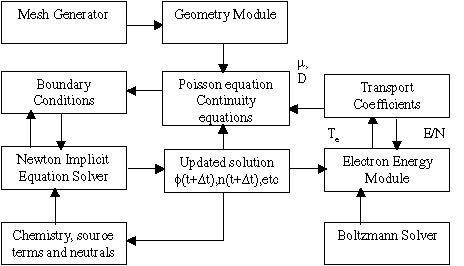

STARTUP PROCESSES IN METAL HALIDE LAMPS*
Ananth Bhoj** and Mark J. Kushner***
**Department of Chemical & Biomolecular Engineering
***Department of Electrical & Computer Engineering
University of Illinois at Urbana-Champaign
1406 W. Green St., Urbana, IL 61801
1. Introduction
High Pressure metal halide lamps high intensity discharge lamps are common illumination sources for large area indoor and outdoor applications. Metal halide lamps operate as multi-atmosphere thermal arcs at steady state, but are more like moderate pressure glow discharges during their startup phase. It could take from a few seconds to minutes for such a lamp to reach steady state. Extending lamp lifetime by minimizing sputtering at the electrodes is achieved by using lower starting voltages. Issues that are also of interest are reducing the high pressure restart times and elimination of radioactive additives such as Kr85. The goal of these simulations is to investigate the basic physical processes occuring during the startup phase.
2. Computational Tool
LAMPSIM is a 2-dimensional plasma hydrodynamics platform developed to simulate the early breakdown and glow phase of startup. This modeling hierarchy is capable of accepting rectilinear or cylindrical unstructured meshes, which are normally used to capture the lamp geometry features. Poisson's Equation is solved for potential along with implicit drift diffusion for charged and neutral species. Local field approximation or electron energy equation is coupled to Boltzmann equation to solve for electron transport coefficients. Source terms include gas phase electron impact and heavy particle reactions, surface chemistry, radiation transport and secondary electron emission sources. External circuit interaction is handled through a circuit model.

Fig. 1: A schematic of the LAMPSIM platform.
In order to validate the model, breakdown times predicted from the simulation were compared to results obtained from experiments.The gas fill consisted of a mixture of Argon and Xenon and the breakdown time measurements were for a range of compositons and gas pressures. Some of the results are presented below.
Whereas in the breakdown regime, thermal effects do not play a crucial role; Well into the glow phase the effects of gas heating might play an important role in evolution of plasma dynamics. To capture these hydrodynamic effects ,LAMPSIM is being interfaced to a 2-dimensional Navier-Stokes solver. An ambipolar approximation module is being developed in order to be able to take larger time steps in the plasma dynamics where the time step of integration is much smaller than that of the Navier-Stokes solver.
3. Results
We considered breakdown in Ar and mixtures of Ar/Xe at pressures of 10s of Torr. The composition of Ar/Xe mixtures is varied at each of these pressures. The applied voltage waveform peaking at 2000V with a rise time similar to the one used in experiments. Animations of some plasma parameters are presented below. A paper discussing model validation with experiments is under preparation.




Animations: Evolution of plasma properties (a) E/N and (b) electron density [e].
In the results shown above, the gas mixture is Ar/Xe at a composition of 5% Xe at a pressure of 50 Torr. The upper electrode is powered while the lower one is grounded. Upon application of the voltage pulse at time t=0, the gas is ionized progressively, reaching breakdown which is indicated by gap closure in [e] animation at about 365ns in this case.
*This work is sponsored by General Electric R&D Center, Electrical Power Research Institute (EPRI) and
NSF (CTS 99-74962, CTS 03-15353)
Last updated: August, 2003.